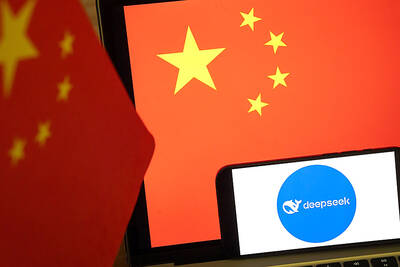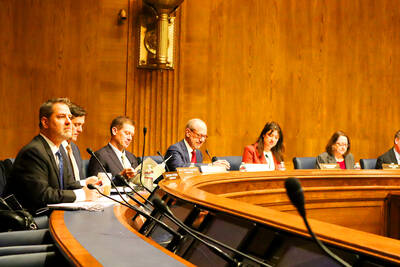China's air force has deployed 12 advanced Jian-10 fighter jets to Zhejiang Province, a news report said yesterday.
"The military is studying why the Chinese military has [recently] been unveiling its development of new weapons in such a high-key fashion, such as the production of J-10 fighter jets and the launching of a ballistic missile to shoot down an orbiting satellite," Ministry of National Defense spokesman Rear Admiral Wu Chi-fang (
"The military wants to know what strategy or goal is behind the posturing," Wu said.
Wu said the military would soon make public information concerning the impact of China's deployment of J-10 fighters.
Chinese state TV last month aired videos that it described as showing that batches of the J-10 fighter -- both the single-seat J-10A and the two-seat J-10B -- had entered operational service.
Footage showed the jets performing aerial maneuvers, including firing air-to-air and air-to-surface missiles.
Wu yesterday did not confirm whether or not the People's Liberation Army Air Force (PLAAF) had deployed J-10 jets in Zhejiang, one of three coastal provinces that abut the Taiwan Strait.
The Chinese-language daily China Times yesterday cited a military source as saying that 12 J-10 jets had been deployed at an air force base around 500km from Taiwan.
The news report said Taiwanese military officials believe that the J-10's combat performance is inferior to that of comparable fighters, such as the Russian-made Su-27 and Su-30 fighters. The PLAAF currently possesses some 400 Su-27s and Su-30s.
Taiwan's air force still sees the Chinese Su-27 and Su-30 fighter jets as the main rivals for Taiwan's advanced fighter aircraft, and uses them as primary targets when conducting computer war games, the newspaper said, without citing a reference.
International military experts believed the PLAAF would produce 300 to 500 J-10 jets, the newspaper said, adding that Taiwan's military intelligence learned China would produce only 120 J-10s, without providing a source.
The newspaper also speculated that the deployment of J-10s would pose a threat to Taiwan's security, and that the new jets would gradually replace PLAAF old J-7 and J-8II fighter jets.
The newspaper said China would send J-8 and J-10 jets force to engage Taiwan's US-made F-16 and French-made Mirage 2000 war planes in the beginning of a cross-strait conflict, before sending its more advanced Russian-made aircraft.
The strategy is to weaken Taiwan's air force through attrition, the news report cited an unnamed military source as saying.
Hong Kong-based defense magazine Kanwa Defense Review Editor-in-Chief Andrei Chang told the state-run Central News Agency earlier this month that China wanted to deter the possibility of instability and tension across the Taiwan Strait this year and next by highlighting its military capabilities.
Chang said, however, that the J-10 jets were no match for late-model F-16s in combat performance, particularly with regard to air-to-surface combat.

MISINFORMATION: The generated content tends to adopt China’s official stance, such as ‘Taiwan is currently governed by the Chinese central government,’ the NSB said Five China-developed artificial intelligence (AI) language models exhibit cybersecurity risks and content biases, an inspection conducted by the National Security Bureau (NSB) showed. The five AI tools are: DeepSeek, Doubao (豆包), Yiyan (文心一言), Tongyi (通義千問) and Yuanbao (騰訊元寶), the bureau said, advising people to remain vigilant to protect personal data privacy and corporate business secrets. The NSB said it, in accordance with the National Intelligence Services Act (國家情報工作法), has reviewed international cybersecurity reports and intelligence, and coordinated with the Ministry of Justice Investigation Bureau and the National Police Agency’s Criminal Investigation Bureau to conduct an inspection of China-made AI language

BOOST IN CONFIDENCE: The sale sends a clear message of support for Taiwan and dispels rumors that US President Donald Trump ‘sold out’ the nation, an expert said The US government on Thursday announced a possible sale to Taiwan of fighter jet parts, which was estimated to cost about US$330 million, in a move that an expert said “sends a clear message of support for Taiwan” amid fears that Washington might be wavering in its attitude toward Taipei. It was the first announcement of an arms sale to Taiwan since US President Donald Trump returned to the White House earlier this year. The proposed package includes non-standard components, spare and repair parts, consumables and accessories, as well repair and return support for the F-16, C-130 and Indigenous Defense Fighter aircraft,

CHECKING BOUNDARIES: China wants to disrupt solidarity among democracies and test their red lines, but it is instead pushing nations to become more united, an expert said The US Department of State on Friday expressed deep concern over a Chinese public security agency’s investigation into Legislator Puma Shen (沈伯洋) for “secession.” “China’s actions threaten free speech and erode norms that have underpinned the cross-strait ‘status quo’ for decades,” a US Department of State spokesperson said. The Chongqing Municipal Public Security Bureau late last month listed Shen as “wanted” and launched an investigation into alleged “secession-related” criminal activities, including his founding of the Kuma Academy, a civil defense organization that prepares people for an invasion by China. The spokesperson said that the US was “deeply concerned” about the bureau investigating Shen

LIMITS: While China increases military pressure on Taiwan and expands its use of cognitive warfare, it is unwilling to target tech supply chains, the report said US and Taiwan military officials have warned that the Chinese People’s Liberation Army (PLA) could implement a blockade within “a matter of hours” and need only “minimal conversion time” prior to an attack on Taiwan, a report released on Tuesday by the US Senate’s China Economic and Security Review Commission said. “While there is no indication that China is planning an imminent attack, the United States and its allies and partners can no longer assume that a Taiwan contingency is a distant possibility for which they would have ample time to prepare,” it said. The commission made the comments in its annual